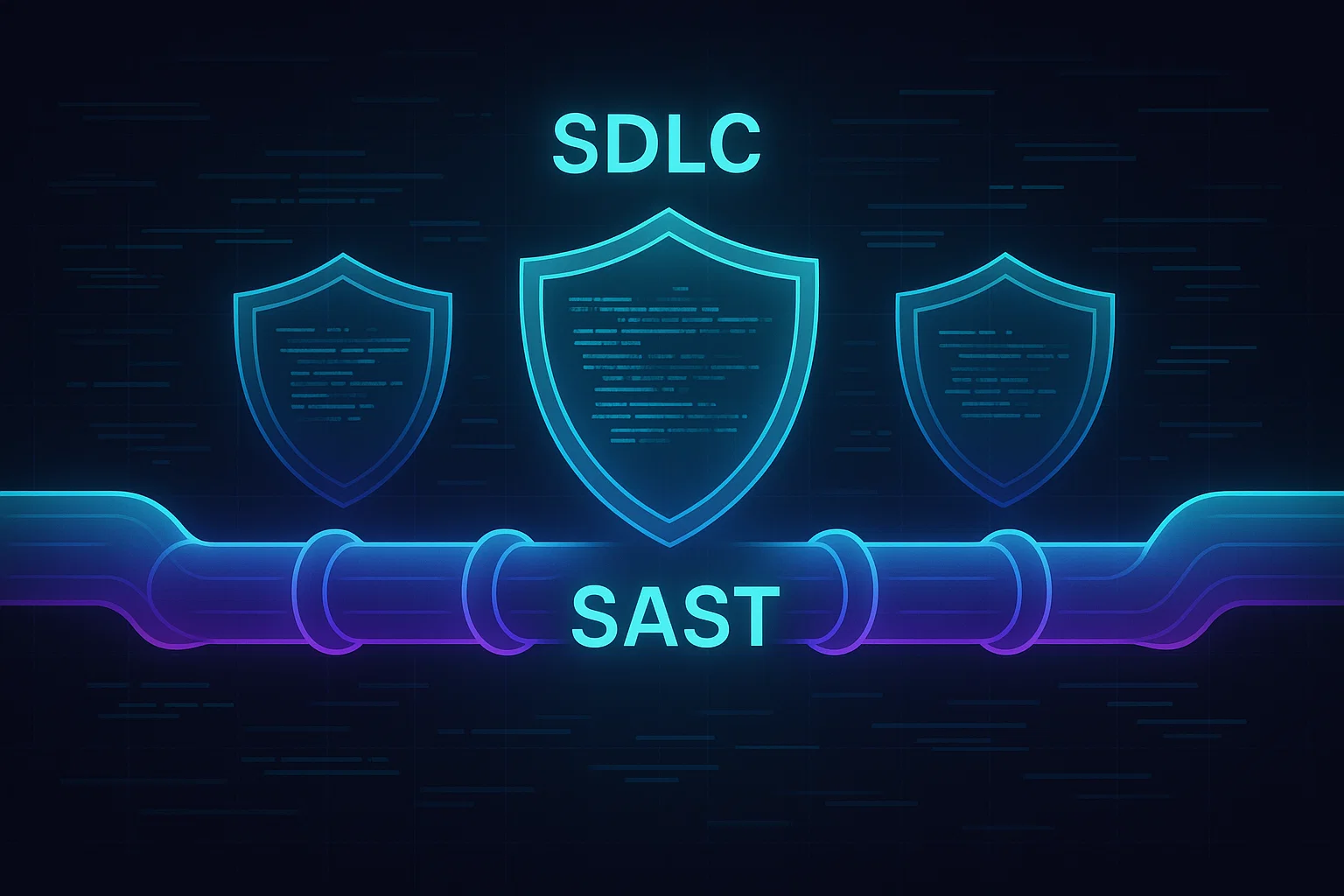DerScanner > Blog > SAST, DAST, and Everything in Between: Making Sense of AppSec Technologies
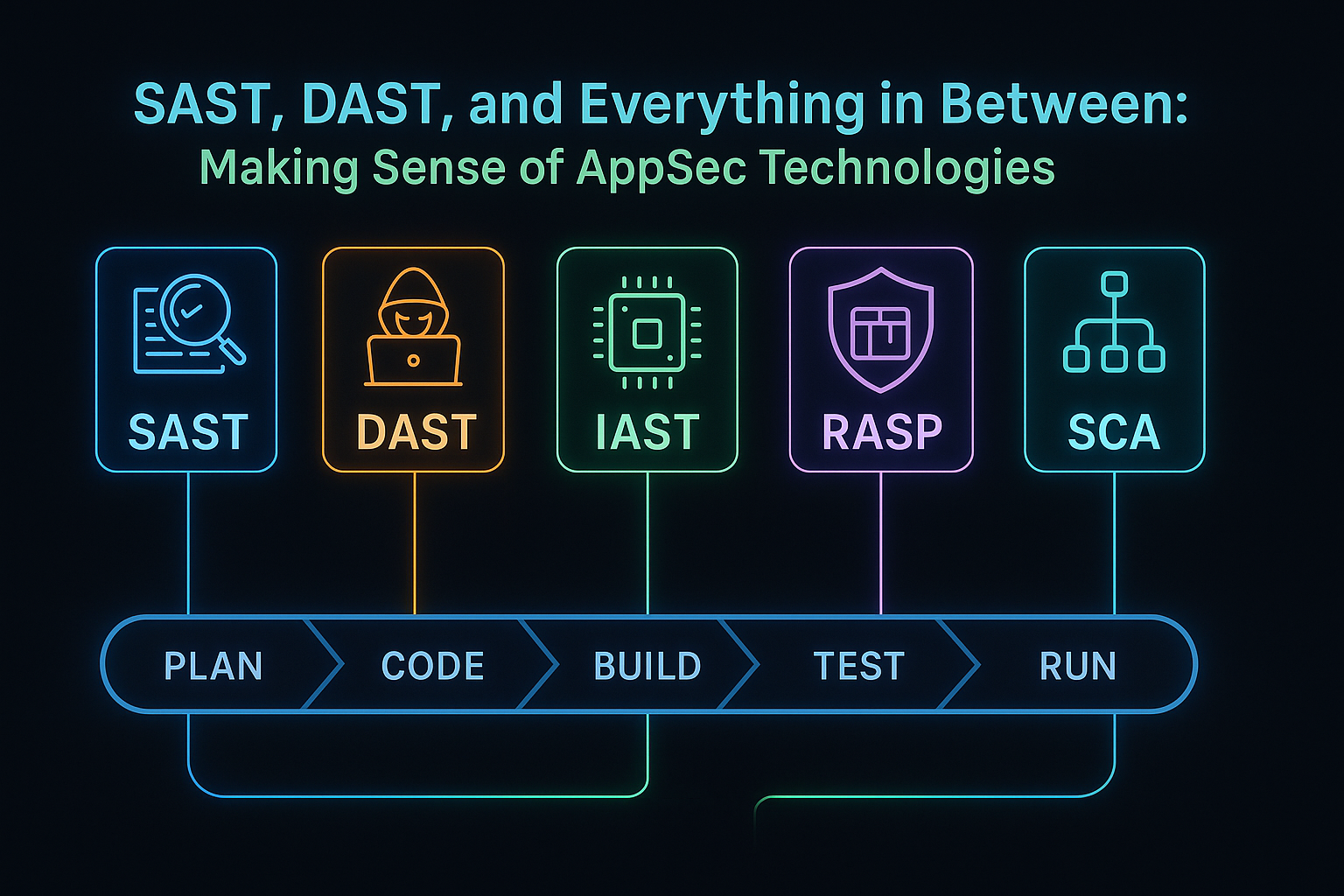
Dan Chernov, DerScanner
SAST, DAST, and Everything in Between: Making Sense of AppSec Technologies
Why Application Security Testing Matters
Applications today sit at the heart of business operations — which makes their security and reliability business-critical issues. They handle sensitive data, transactions, and daily operations, which also makes them a top target for attackers. In 2025, web application and API attacks surged to over 311 billion incidents, and nearly 6 out of 10 of these data breaches were caused by flaws in the application on a non-infrastructural level.
Hackers actively exploit misconfigurations, weak encryption, and coding flaws such as SQL Injection or XSS. When attacks succeed, the impact extends beyond data theft — leading to high costs of downtime, regulatory exposure, and erosion of customer trust.
Application Security Testing breaks this cycle by shifting defense earlier in the lifecycle. It uncovers vulnerabilities before they can be weaponized, reducing breach costs, preventing downtime, and protecting the trust and safety of customers — all while keeping business running without interruption.
Understanding the Basics of AppSec Technologies
Application security (or AppSec) — is the way of safeguarding software against exploitable and non-exploitable vulnerabilities. It emerged when organizations realized that firewalls and network defenses alone could not stop threats embedded in the code itself. Attacks such as SQL Injections and Cross-Site Scripting underscored the need for dedicated testing tools to identify weaknesses before they hit the production.
Modern applications are built on open-source components, third-party APIs, and cloud platforms, dramatically expanding the attack surface. To manage this complexity, development teams have embraced DevSecOps and integrated secure coding practices that check for risks at every stage of the lifecycle — reducing exposure, cutting remediation costs, and preserving user trust.
The main AppSec technologies include
- Static Application Security Testing (SAST)
- Dynamic Application Security Testing (DAST)
- Interactive Application Security Testing (IAST)
- Runtime Application Self-Protection (RASP)
- Software Composition Analysis (SCA) tools
These approaches cover code analysis and active runtime protection. Together, they form what AppSec looks like.
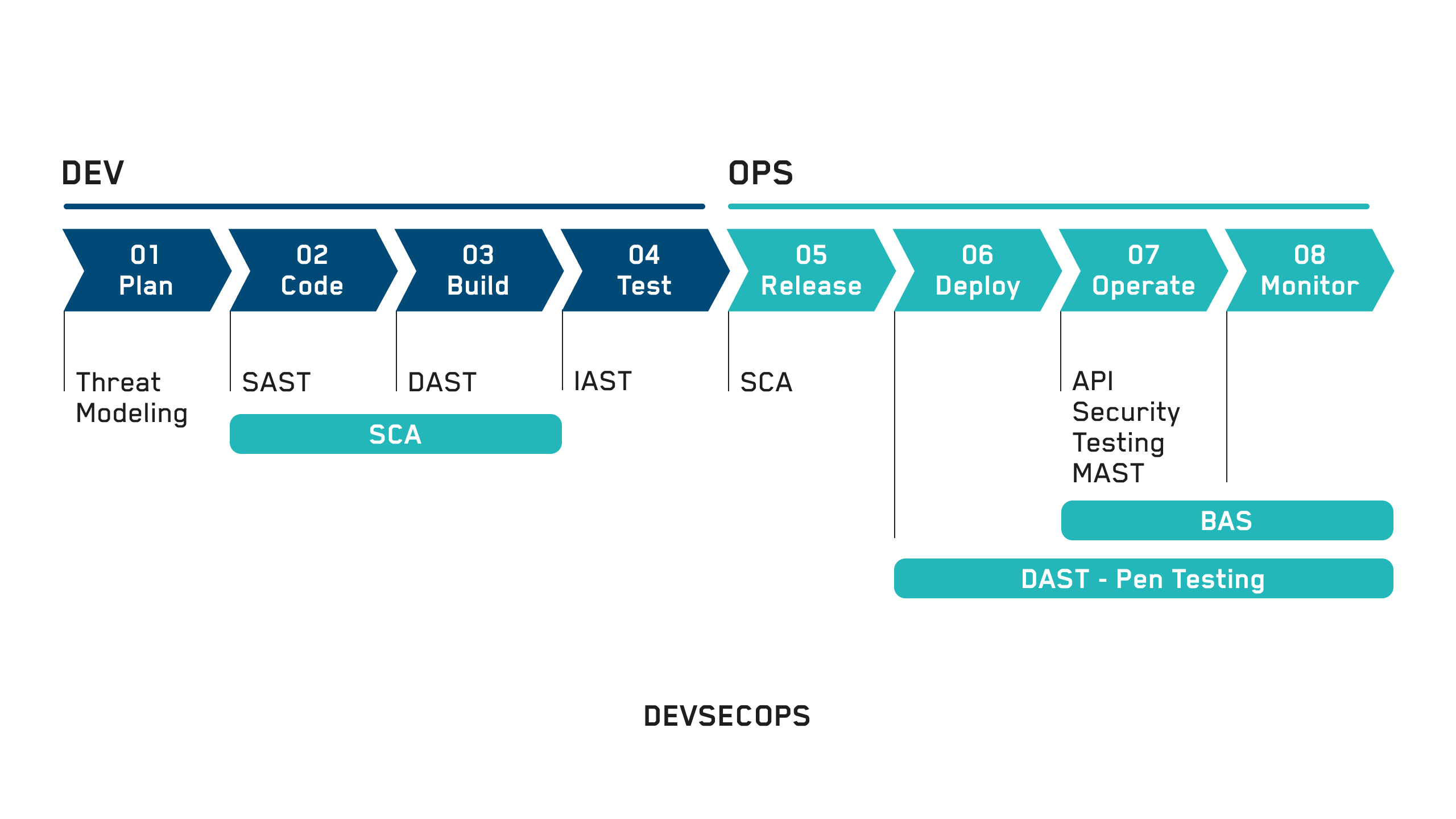
What is SAST? (Static Application Security Testing)
Static Application Security Testing is a white-box testing approach that scans source code, bytecode, or binaries without actually running the app. It works by using data flow analysis or control flow analysis (and many more) techniques to detect security issues like:
- SQL injection
- cross-site scripting
- insecure deserialization
- buffer overflows
- hardcoded credentials or API keys
- missing or improper authentication checks
- insecure role-based access enforcement (authorization bypass)
- insecure default configurations
- disabled or missing security checks (e.g., SSL certificate validation bypass)
- use of dangerous functions/APIs (strcpy, eval, exec)
- etc
SAST has become important in the secure software development lifecycle. When developers add it to CI/CD pipelines, the technology helps DevSecOps practices by giving quick feedback that shows up right in IDEs or version control systems. Problems get marked at exact code lines, with background info and fix tips.
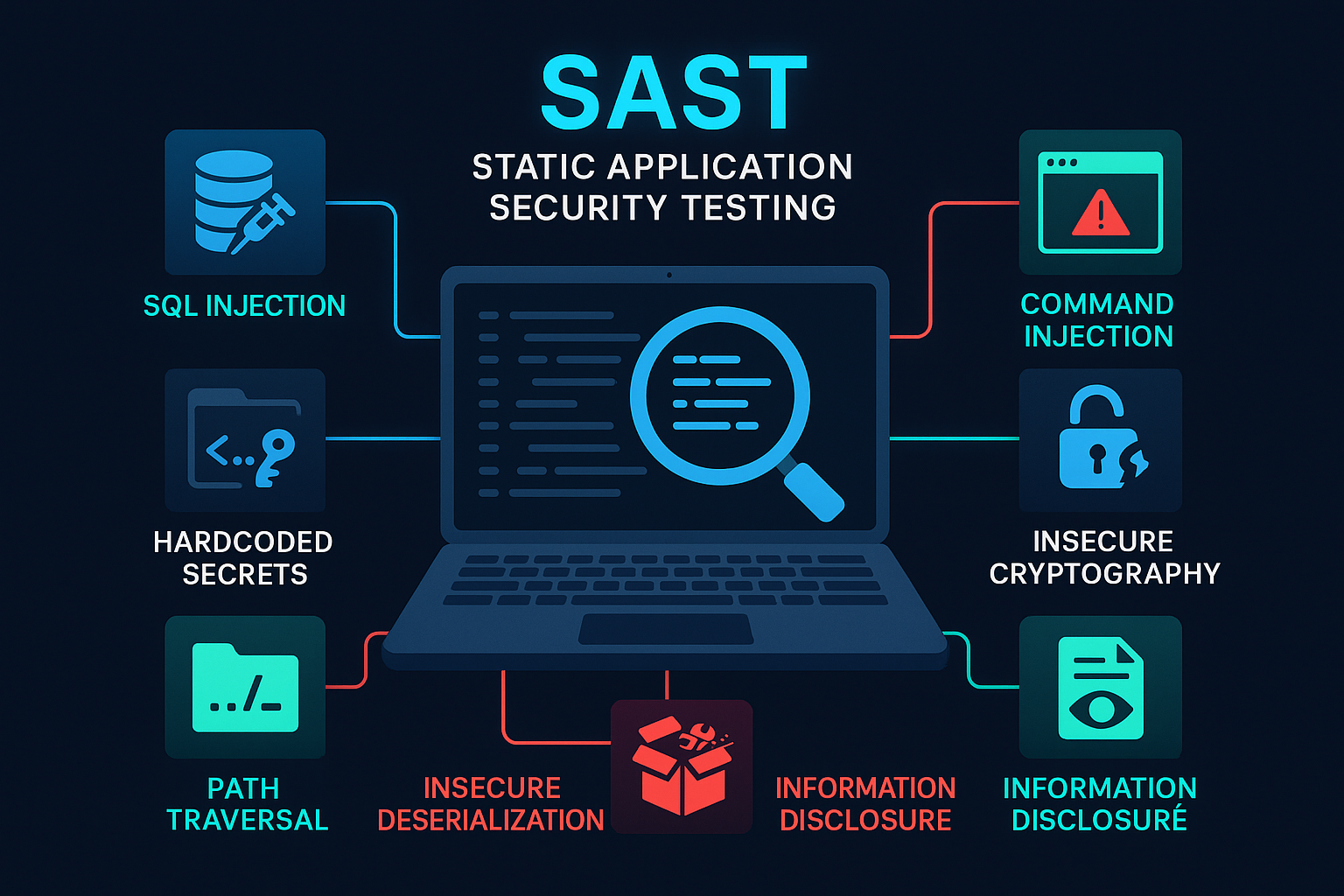
Developers usually run a SAST tool while they're coding or during commits. The software finds bad code patterns, explains the security risk, and gives safer coding options that help make the application stronger before it goes live.
What is DAST? (Dynamic Application Security Testing)
Dynamic Application Security Testing (DAST) works as a black-box testing approach that checks an application while it's actually running. Different from Static Application Security Testing, DAST doesn't need the source code at all. Instead, it tests the app "from the outside in" by acting like a real attacker trying to break into the system.
DAST catches problems that only show up when the app is live. These include:
- Misconfigured servers
- Authentication issues
- Denial-of-Service attacks
By watching how an application reacts to fake attacks, DAST helps dev teams build better defenses for the real world.
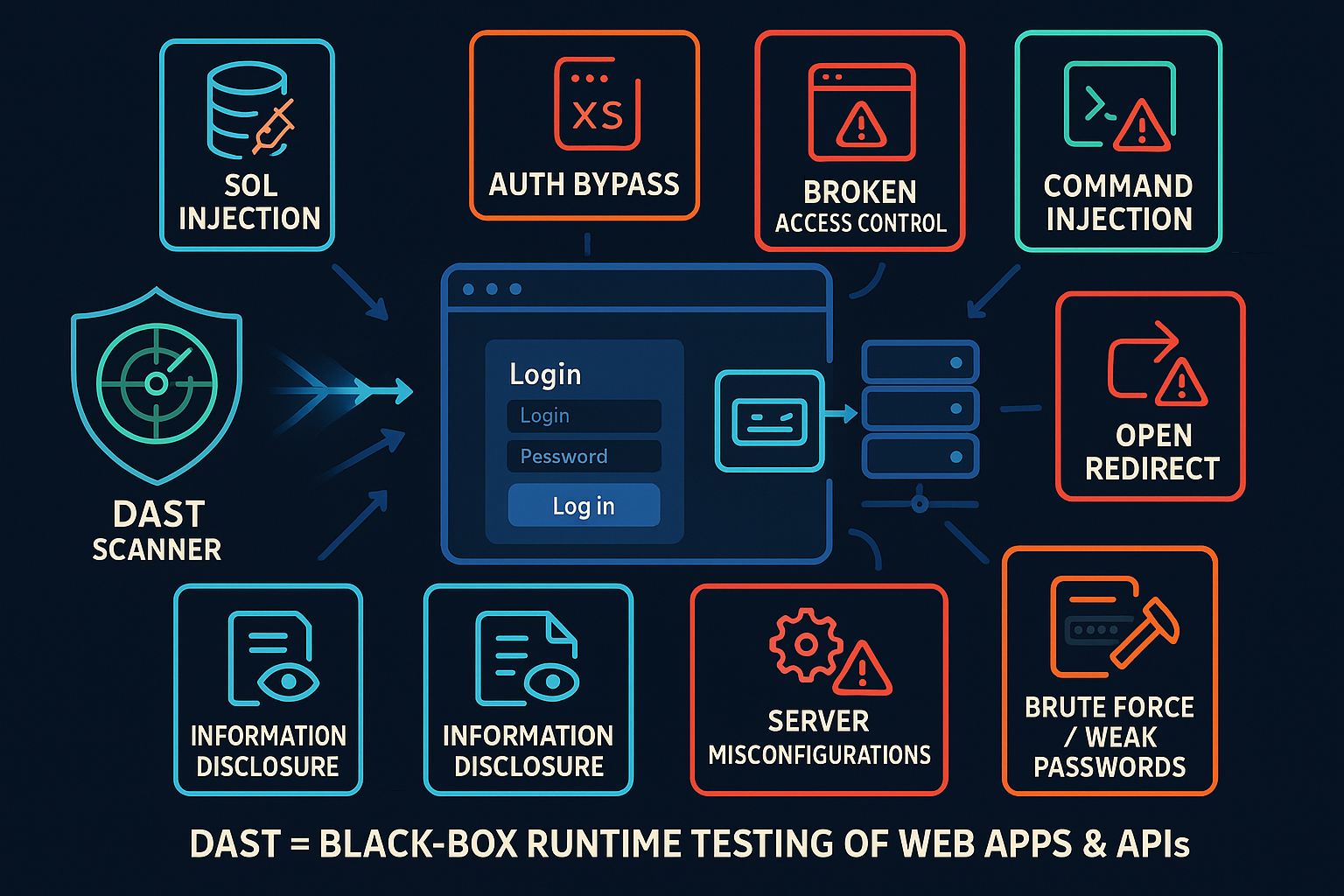
Where IAST, RASP, and SCA Fit In
SCA has become a baseline in AppSec today. If you’re using open-source code, you need to know what’s in it, which versions you’re running, and where the risks are. IAST and RASP are a bit different. They can add value in certain situations, like IAST during testing, RASP in production, but they’re not something every team relies on. SCA is the everyday tool, while IAST and RASP are more like nice extras if you’ve got the need and resources.
SCA - Software Composition Analysis
This focuses on third-party and open-source components. SCA scans through dependency files to create a Software Bill of Materials or SBOM. This makes a complete list of every library your application uses. It also tracks the components’ versions and licenses. The tool then checks everything against known CVEs. You can detect problems in third-party code quickly this way. Getting them fixed becomes much quicker, too.
IAST - Interactive Application Security Testing
Works inside a running app with agents that track real code execution during functional or integration tests. It combines the strengths of SAST and DAST, giving developers precise details such as file, line number, and variables tied to software vulnerabilities. IAST fits best in test or staging environments where automated test coverage is strong, because it relies on real requests and interactions to trigger vulnerabilities.
RASP - Runtime Application Self-Protection
Runs within the application in production. It enforces security policies by intercepting malicious inputs in real time, adding a layer of runtime protection that goes beyond traditional methods. RASP fits in live production systems where ongoing protection is needed against active threats.
SCA fits nicely into different components of the secure software development lifecycle (SSDLC). You can run it during build pipelines. Furthermore, you can use it for routine checks on codebases to keep dependencies secure and up to date.
Key Differences Between SAST and DAST
Here's a breakdown of the main differences between SAST and DAST.
| Criteria | SAST (Static Testing) | DAST (Dynamic Testing) |
| Type of Testing | White-box analysis (inside-out) | Black-box analysis (outside-in) |
| Stage in SDLC | Performed early in the development (during coding/build phases) | Conducted later, in QA or after deployment on a running app |
| Access to Source Code | Required - scans source, bytecode, or binaries | Not required - tests a deployed application via its interfaces |
| Vulnerability Coverage | Identifies code-level errors before runtime
|
Detects runtime issues that manifest only when the app is running
|
| Accuracy (False Alerts) | Produces more detections overall due to broader code coverage (fewer false negatives), but can generate false positives when it flags insecure code patterns rather than actual exploitable issues | Produces fewer detections overall because it has limited access to the codebase (higher risk of false negatives), but the findings are usually more reliable since they’re validated through actual exploits |
| Technology Dependence | Language/framework dependent, and the tool must support the app’s tech stack | Largely tech-agnostic. Interacts with the app via HTTP/UI, so language doesn’t matter |
| Fix Cost & Effort | Detects issues early when they cost less to fix | Finds issues late (just before or in production), so fixes are more expensive and potentially delay releases |
| Integration | Integrated into developers’ IDEs and CI/CD pipelines for continuous scanning (enables “shift-left” security | Often run in a test/staging environment or as part of late-stage CI/CD scans to simulate attacks before release |
Pros and Cons of Each Approach
Every Application Security Testing method has advantages and disadvantages. Here's what works well and what doesn't with each of these AppSec technologies.
Pros and Cons of SAST
|
Pros |
Cons |
|
|
Pros and Cons of DAST
|
Pros |
Cons |
|
|
Pros and Cons of Other Methods (IAST, RASP, SCA)
|
IAST |
RASP |
SCA |
|
| Pros | Combines static and dynamic techniques. Offers highly accurate results with fewer false positives. Gives real-time insights during functional or integration tests. |
Protects live apps by blocking attacks in real time. Has a deep application context, which allows it to make more accurate decisions than external defenses like firewalls or web application firewalls (WAFs) | Flags known CVEs and helps with license compliance. Produces a Software Bill of Materials for better visibility |
| Cons | Requires agent deployment. This can affect performance and may support limited frameworks. Complex and costly to implement at scale. |
Requires an in-app agent, which can add latency. Adoption is still maturing, with limited stack support. Has the risk of misconfiguration | Limited to known vulnerabilities in public databases. Cannot detect issues in custom code. May raise alerts on unused vulnerable code paths, requiring manual impact analysis |
Common Use Cases and Scenarios
Each AppSec technology is best suited for specific situations. Let’s take a closer look at the most common scenarios among them.
| SAST | DAST | IAST | RASP | SCA |
|
|
|
|
|
Choosing the Right AppSec Technology
Picking the right mix of AppSec technologies depends on various factors.
Factors to Consider (team size, SDLC maturity, compliance, budget)
1. Team size & expertise
The people you have on the ground will impact what you can realistically run. A big enterprise with dedicated security engineers can juggle several specialized tools to handle their results.
Small startups usually work better with tools like SAST or SCA. These fit right into IDEs or CI pipelines without needing much setup time. IAST and RASP are more advanced options. But they come with extra work. You'll need to install agents. Need to spend time tuning them, and keep maintaining everything. These complex tools only make sense when your team has enough people and skills to handle all that extra responsibility.
2. SDLC maturity
How well your team knows Agile or DevOps also makes a difference. If you've got a solid CI/CD pipeline set up, you can plug in tools like SAST, SCA, or even IAST to get ongoing feedback.
On the other hand, DAST scans before production may be more practical if releases are slower or manual. The goal is to match tools to your actual workflow instead of forcing something that slows delivery.
3. Compliance requirements
For many industries, compliance sets the bar. Standards like PCI DSS, HIPAA, or SOC2 often require proof of regular Application Security Testing. That might mean
- SAST to meet code review mandates.
- DAST to demonstrate runtime testing.
- SCA to show you’re tracking known vulnerabilities in dependencies.
Sometimes contracts or customers demand reports, such as a penetration test, so the tools you choose should support these obligations.
4. Budget and cost
Money is always a factor. Enterprise-grade tools can be pricey and may charge per user or per scan. Add in the staff time to configure and triage results, and the cost grows quickly. If resources are limited, free tools like OWASP ZAP (DAST) or dependency-check (SCA) can still provide value.
Sometimes the smarter choice is mixing free options for broad coverage and paying for one strong commercial tool where it matters most. Always weigh the cost of a tool against the cost of leaving software vulnerabilities unchecked.
Combining SAST, DAST, and Other Tools for Maximum Coverage
Choosing an Application Security Testing approach is not a simple decision between SAST vs DAST. Most teams need a combination of tools, because each one looks at security from a different angle.
For code-heavy projects in early development, SAST and SCA tools are a priority. They catch coding flaws and dependency risks before deployment.
For mature apps or third-party services without source code, Dynamic Application Security Testing (DAST) becomes vital. Examples include scanning a commercial SaaS product your company integrates with or evaluating an outsourced web portal built by a vendor.
Fast-moving DevOps teams may use IAST for real-time checks during testing, while RASP adds runtime protection for production systems.
Start small if resources are limited. Add more methods as your secure software development lifecycle (SDLC) evolves.
How AppSec Testing Fits Into DevSecOps
In DevSecOps, security is built into the pipeline instead of being bolted on at the end. Application Security Testing tools are automated at different stages, so vulnerabilities are caught as the code moves forward.
- Early stage - SAST scans each commit or pull request for common coding flaws (e.g., OWASP Top 10). This prevents risky code from being merged.
- Early and build stage - SAST subset of tools flag vulnerable dependencies and check licensing issues. Secret scanners verify that no credentials are exposed.
- Test stage - DAST tools are deployed in staging to detect runtime issues.
- Post-deployment - Continuous DAST or monitoring keeps checking for new threats.
Shift Left with SAST
“Shift left” means moving security checks to the earliest stages of development. Static Application Security Testing is central to this because it runs directly on source code, long before the app goes live. Developers can scan commits or even receive feedback inside their IDE, catching issues like insecure input handling or hard-coded secrets while coding.
Modern SAST tools such as GitHub CodeQL, Semgrep, and Checkmarx integrate with CI/CD, blocking critical issues before merges. This early detection reduces costly fixes later in production and builds a habit of secure coding.
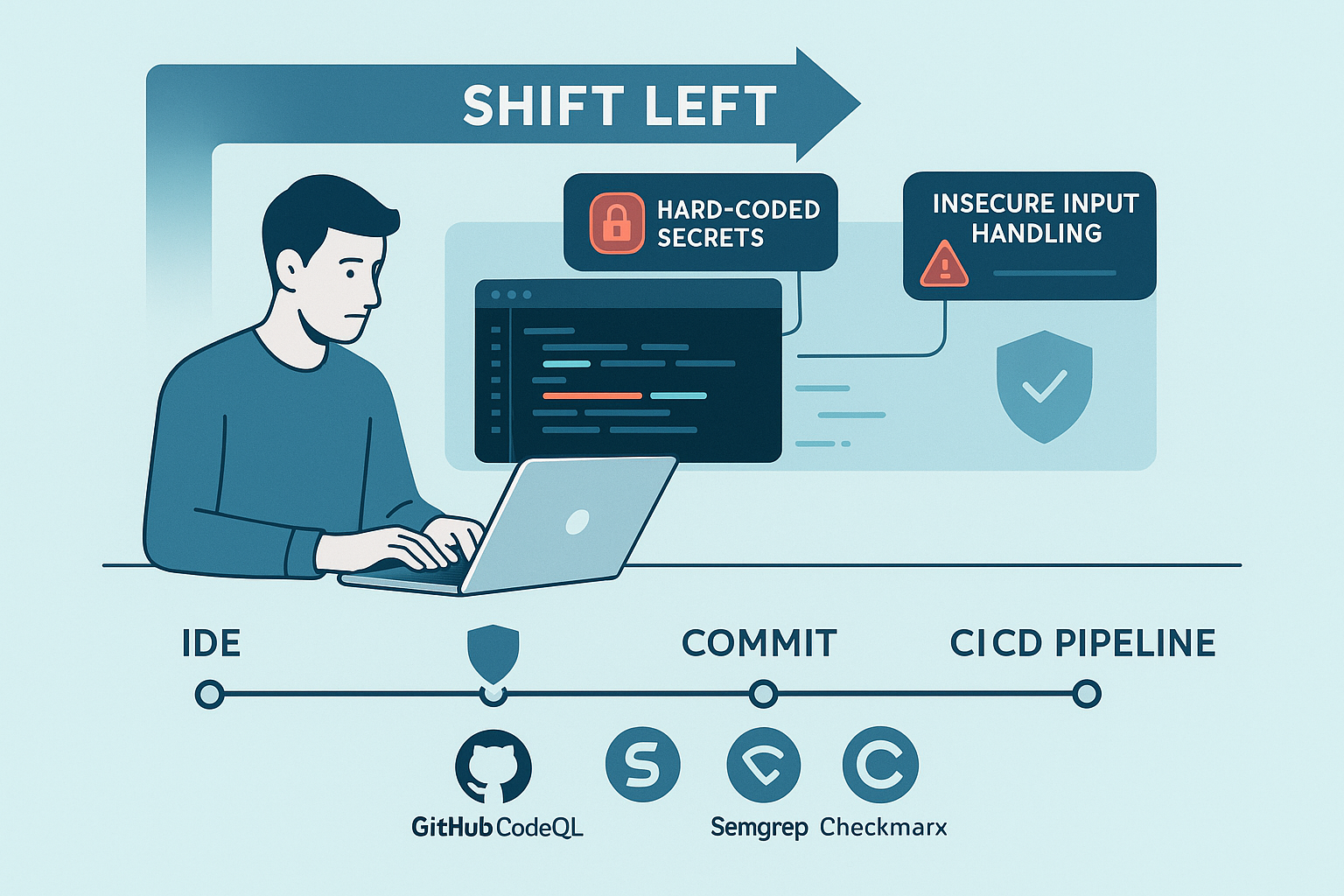
DerScanner SAST
DerScanner is a full-cycle application security testing platform. It provides enterprise-grade coverage with unified SAST, DAST, MAST, SCA, and Binary Analysis in one solution.
One of its prominent offerings is Static Application Security Testing. By shifting security left, DerScanner helps identify vulnerabilities early in the development lifecycle, before they become costly issues. Security checks run automatically during development, so you can release faster without sacrificing safety.
It integrates directly with GitHub, GitLab, Bitbucket, Jenkins, SonarQube, and popular IDEs like Visual Studio Code, Eclipse, and IntelliJ IDEA.
DerScanner supports 43 programming languages in total. Some of the main ones include Java, JavaScript, TypeScript, Python, C, C++, C#, and PHP. It also works with Kotlin, Swift, Ruby, Go, and many others by giving teams the flexibility to test polyglot codebases across different environments.
DerSecur, which has developed DerScanner, was recognized among notable vendors in The Static Application Security Testing Landscape, Q2 2025.
Continuous Monitoring with DAST and Beyond
Security isn’t a one-time check; code changes, configs, and new CVEs create risks every day. Continuous monitoring with DAST means scanning applications on a regular basis, not just before release. Many teams schedule nightly or weekly scans in staging or production-like environments to quickly catch runtime issues.
In DevSecOps best practices, this continuous approach is paired with alerting and ticketing so developers can act as soon as vulnerabilities appear. Beyond DAST, runtime tools like RASP add real-time protection, blocking attacks inside the application itself. Together, these methods keep applications resilient even as threats evolve post-deployment.
DerScanner SAST / DAST Correlation
DerScanner introduced a dedicated module for SAST and DAST correlation, bringing static and dynamic analysis into one unified process.
The module combines static code analysis with dynamic testing through simulated external attacks. With SAST and DAST correlation, findings from static scans are cross-checked by dynamic analysis, so teams can focus on issues that are confirmed and actionable. This reduces false positives and simplifies remediation.
This approach improves accuracy while easing the workload on AppSec teams. The correlation engine cuts through noisy results and accelerates vulnerability management.
Looking ahead, DerSecur plans to expand SAST and DAST correlation with additional technologies, further strengthening its role as a full-cycle security testing platform.
AI-Driven Vulnerability Detection
AI is now embedded across almost every corner of AppSec testing. In SAST, vendors like DerScanner, Checkmarx, Snyk Code, Veracode, and SonarQube use machine learning to cut false positives, speed up code scanning, and suggest fixes.
For example, Checkmarx reports faster results with fewer false alarms, while Snyk’s DeepCode engine offers fix recommendations directly in IDEs.
In DAST and IAST, AI enables smarter runtime testing. These tools not only find errors but also auto-generate and validate fixes to reduce manual retesting. ML-driven fuzzing replaces random test generation and makes it easier to expose complex logic flaws.
For runtime protection, AI supports anomaly detection in RASP and modern WAF/WAAP solutions. Unlike rule-based systems, these tools learn normal app behavior and block deviations in real time, even if they don’t match a known signature. This makes them more effective against zero-days or multi-stage attacks.
AI also assists developers through tools that flag insecure code patterns in real time and suggest secure alternatives.
Compared to traditional methods, AI reduces noise, detects exploitable issues first, and accelerates remediation.
DerScanner and DerCodeFix
DerCodeFix is one of the standout AI features of DerScanner. It focuses on fixing vulnerabilities right at the code level instead of giving broad recommendations. When it finds an issue, it takes the actual snippet of code and applies the changes needed to remove the security risk. Developers don’t have to guess what to do; the fix shows up directly in their results.
You can run DerCodeFix during the scanning stage or later when looking through the findings. In scan settings, it’s possible to set severity levels or only generate patches for issues already confirmed by DerTriage, DerScanner’s tool for automatically verifying SAST detections and filtering out false positives. The fixed code appears in the results panel with the changes highlighted, and you can quickly toggle between the original and the patched version.
If you want to go straight to a specific issue, you can open it and trigger DerCodeFix on the spot. The tool will show what changed and give a short explanation so you know why the fix matters.
Conclusion: Building a Balanced AppSec Strategy
Application Security Testing is not about choosing SAST vs DAST, but about combining methods for stronger coverage. A balanced approach uses Static Application Security Testing early in development, Dynamic Application Security Testing in runtime, and extends with IAST, RASP, and SCA tools where needed.
Platforms like DerScanner add value with SAST and DAST correlation, reducing noise and speeding remediation. By following DevSecOps best practices, teams can build security into every stage and keep applications resilient against evolving threats.
FAQs
- Do I need both SAST and DAST?
Yes. SAST finds code-level flaws early, while DAST catches runtime issues later. Using both gives broader coverage across the SDLC. - What’s the main drawback of SAST?
It can create false positives, which means extra triage work. Modern AppSec technologies reduce this noise and give developers fixes they can act on quickly. - Can DAST be run in production?
It can, but only with safe setups. Many teams follow DevSecOps best practices and run them in staging, or use limited production scans to reduce risks. - What makes DerScanner different from other tools?
DerScanner is a full-cycle Application Security Testing platform. It unifies SAST, DAST, MAST, SCA, and binary analysis in one solution, and even supports SAST and DAST correlation to cut down false positives. - Does DerScanner support CI/CD pipelines and developer tools?
Yes. It integrates with GitHub, GitLab, Bitbucket, Jenkins, and SonarQube for pipeline automation, and it also connects with IDEs like VS Code and IntelliJ so developers can run security checks directly while coding. - How do I choose the right AppSec tools for my team?
Think about scale and needs. A small team may start with SAST or SCA tools, while larger teams often combine SAST, DAST, and even IAST or RASP for deeper coverage.
Share with:
You will definitely like these articles

Static Analysis: How to Do It Right?
2020-04-06
All the Truth about Static Analysis
2020-04-20